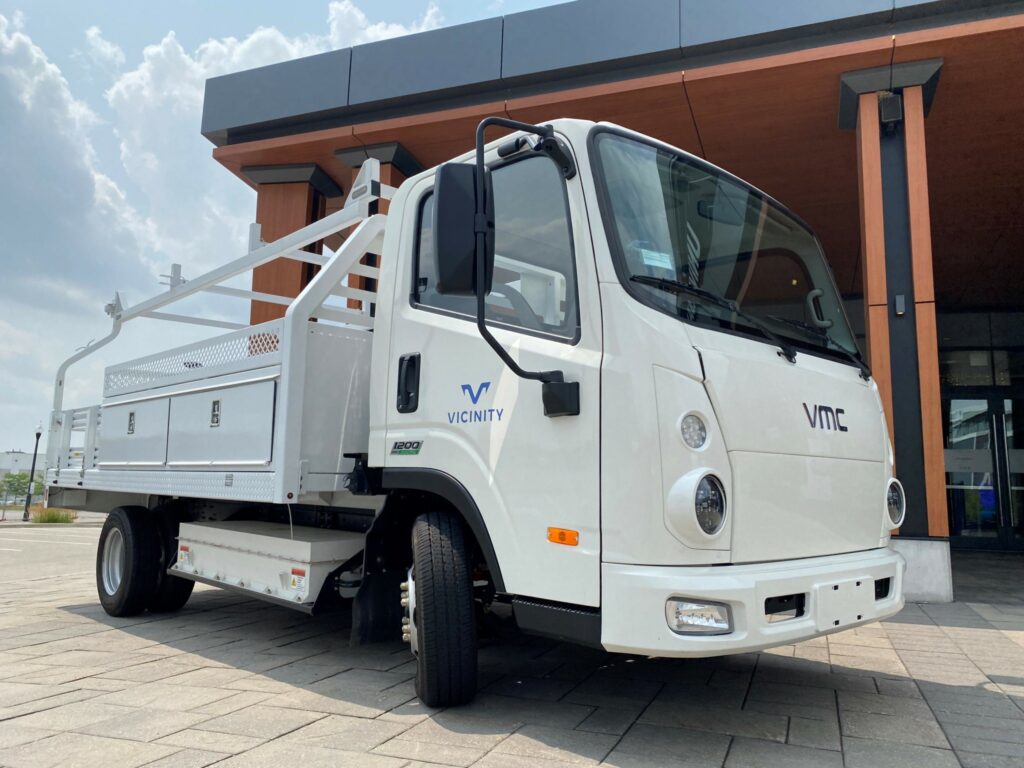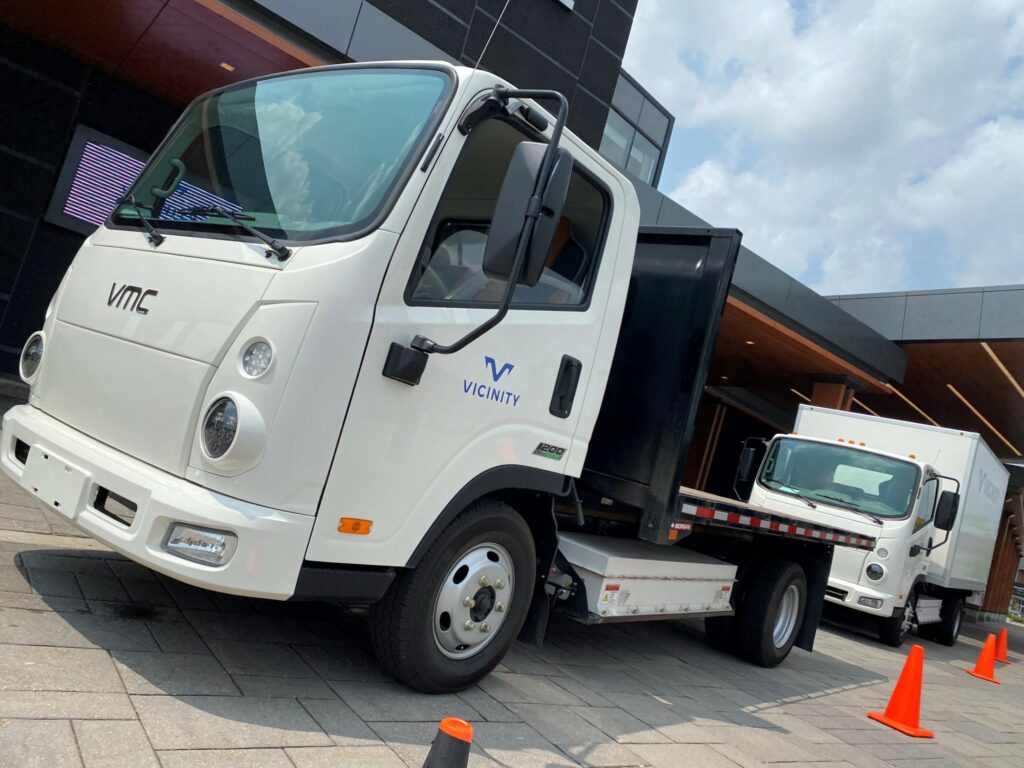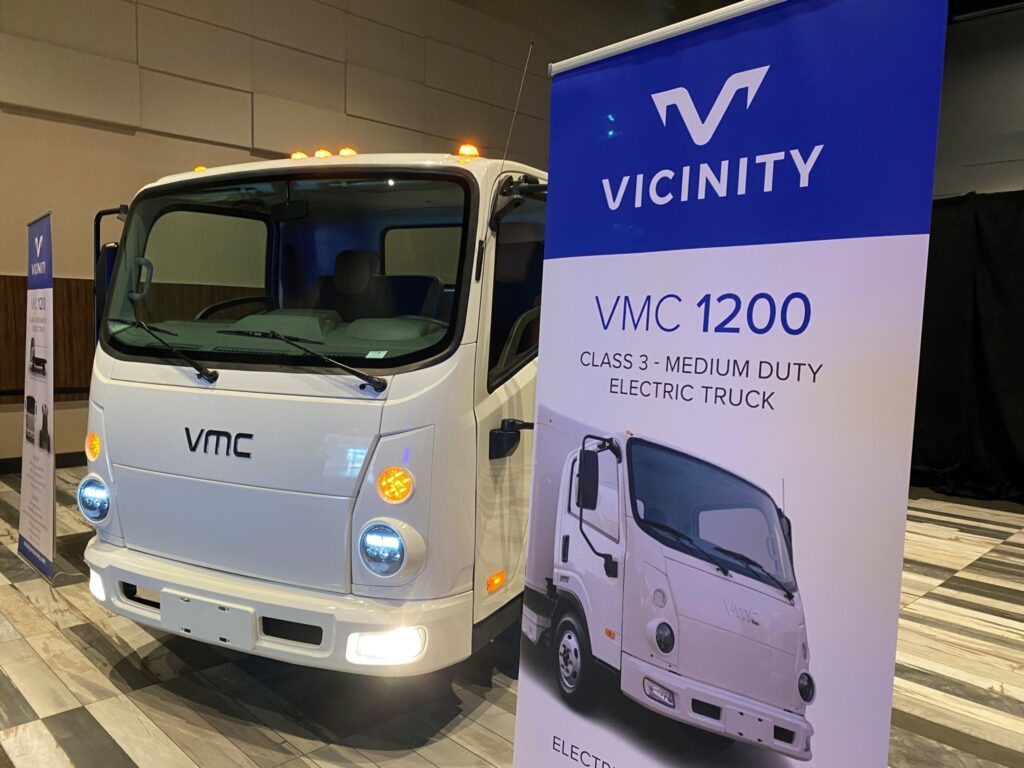VMC rolls out first electric trucks, looks to build national distribution network
A little known Canadian electric truck maker has brought to market a Class 3 truck and is now in the process of establishing a nationwide distribution network.
The first of Vicinity Motor Corp.’s (VMC) Class 3 EVs have found a home where you wouldn’t necessarily expect to find such vehicles, having been deployed with Lafarge in B.C., where they’re used to transport aggregate and related materials to local customers.

Now, the company is looking to develop a distribution network in key markets across Canada, and to do so it brought a selection of its trucks to Vaughan, Ont., this week in an effort to develop those relationships. VMC has partnered with consulting firm DSMA to develop its dealer network. Rick Kingdon is director – open point placement, with DSMA, and he told TruckNews.com what the company is looking to achieve as it readies for a broader rollout.
“We think a perfect fit is a current dealer, that deals in fleet,” Kingdon said. “VMC is looking for distributors that are sophisticated, have their own systems in place, and their own relationships with end users.”
They’ll need connections, knowledge, facilities (including hoists) and expertise (including technicians trained on servicing EVs).
Because the VMC 1200 is a truck well suited for final mile deliveries and other urban applications, the company is looking to set up a network with a presence in major Canadian markets such as Calgary, Edmonton, Toronto, Montreal, and even in the Atlantic provinces.
“This event is crucial,” Kingdon said of the three-day event in Ontario, which in many cases exposed the brand and vehicle for the first time to prospective distributor partners. “It’s a chance for them to meet with VMC, their executives, and find out the direction of the company. It’s been around since 2008 so it’s not a startup. Then, they can see the product, talk to the engineers, do a walk-through and also a test drive.”
The company
VMC got its start in 2008 as a manufacturer of mid-sized buses based in Aldergrove, B.C. Today, it claims to own 90% of the Canadian mid-sized bus market in which it participates, but that market is subject to a seasonality and cyclicality that left it seeking other markets in which to expand to help navigate the troughs. VMC’s EV bus platform and related architecture were easily adaptable to the commercial truck market, and so the VMC 1200 was born.
A clear frame rail and back-of-cab were maintained to simplify installation of a wide range of bodies for upfitters, noted Brent Phillips, senior director of sales for VMC. He compared the cab and chassis to Lego – a platform upon which customers can easily build whatever type of vehicle they require.
“It’s like a Transformer of trucks,” Phillips joked.
Early interest has come from companies in the last mile delivery and landscaping segments, with customers looking for mini-dumps, flatdecks, and van bodies. But some inquiries have surprised even VMC itself. One prospective customer wanted to upfit a box body and convert it into a mobile pizza kitchen to support its brick-and-mortar location, recalled Umrao Nagi, director of service operations.
The 100-kWh battery pack can provide about 240 km of range, fully loaded, Phillips claimed. And its payload can be up to 4,500 lb, depending on body type. The trucks are assembled in Aldergrove, with a second plant in Ferndale, Wash., set to open in September. But Phillips said the company is looking to firmly establish itself in the Canadian market before branching south.
“There’s a lot of interest in the U.S.,” he acknowledged. “But ‘Canada first’ is a term we coined. It’s usually the other way around; how many does Canada get? The question is going to be, how much does the U.S. get? We are going to develop our market here, and our service model and all the infrastructure we need, protect that and get it working well. Right now, our strategy is for a limited launch in the U.S. 12 to 18 months from now. We want to be very measured and don’t want to do anything that will take our eye off the ball in Canada.”
By the end of the year, VMC will have capacity to produce about 2,000 trucks a year, ramping up to 3,000 next year. “We can scale from there,” Phillips said. “Our plan goes well beyond that.”
The company feels it has carved out a nice niche that isn’t overly crowded, complementing existing offerings in the commercial truck space. Asked how it views other fledgling electric truck makers such as Lion Electric, Phillips said “We are where they’re not. We’re excited for them and what they’ve got going on. We saw where our niche is and focus there. I’d say we probably don’t have any vision for the Class 7 market or the school bus market.”
He added, “One of the things that makes us unique is we don’t compete against any other OEM in this platform and category right now.”
There are, however, plans for a Class 5 truck to be introduced next year, which VMC says will come in a 19,000 lb. GVWR with enough battery capacity to travel 400 km.

The truck
The highlight of the demonstrations was the opportunity to take the VMC 1200 out on the road. Each model on display was based on a standard spec’, the only difference being the range of bodies attached. I chose a flatbed for my drive around the Universal EventSpace on Hwy. 7.
First impression as I climbed into the cab: The VMC 1200 is a truck that’s powered by batteries, not an EV that’s trying to be a truck. The interior is functional with attractive finishes, but it won’t be confused for a luxury vehicle. It’s devoid of gimmicks. You won’t find a TV-sized tablet mounted to the dash to distract the driver.
Nor will you find other futuristic concepts, say, for example, a seat that’s positioned in the center of the cab. The truck’s interior is familiar and comfortable for anyone accustomed to driving traditional work trucks – and that was by design.
“We worked with a partner on the cab design,” Phillips explained as we climbed inside. “It’s very spacious, ergonomic, and comfortable. No frills – it’s a work truck.”
The dash layout is an intuitive combination of digital displays and traditional gauges. The windshield and side windows are expansive, to give the driver an excellent view of the road or worksite.
Transitioning from a diesel or gas-powered truck into the all-electric VMC is intuitive and effortless. The regenerative braking won’t pitch the driver forward upon letting off the throttle. It’s also not adjustable from inside the cab, so there’s one less setting for a driver to fiddle with. The only surprise for those not accustomed to driving an EV will be the lack of noise and instant torque.
Comparisons of commercial EVs to oversized golf carts are getting tired, but the analogy is overused because it works.

What did stand out as a differentiator to other commercial EVs is the quietness of the cab, which suggests a solid construction. The silence of an EV powertrain uncovers a lot of sins in terms of cab construction – you hear every squeak and rattle an internal combustion engine would normally drown out. The VMC produces an extremely quiet ride and very little in the way of such noises.
It may be a no-frills interior, but standard features include air-conditioning, tilt and telescopic steering, power windows and locks, keyless entry, and three-person seating.
The VMC’s funky looking front exterior offers a nod to the company’s bus roots. Flat-faced and bug-eyed, it’s not the most aesthetically pleasing design, but it is a functional offering excellent for those inner-city deliveries or crowded worksites.
The gross vehicle weight rating (GVWR) is 12,000 lb., with 6,000 lb. of payload (not including the body). Top speed is 104 km/h and max power is 120 kW, or 160 hp. Its fully loaded range is 240 km, the company says, but the truck is likely to be put into duty cycles that are empty for at least a portion of the route.
VMC has opted not to get into the charger game, remaining brand agnostic and leaving the fleet to decide on the best Level 2 or 3 charger for its own needs. Both are compatible. A full charge takes about five to seven hours if using a Level 2 charger, while a Level 3 can get it done in just 2.5 hours.
The VMC 1200 is a versatile truck, compatible with a full range of body types. If you’re looking for a common body – say, a mini-dump, dry van or flatdeck – the truck will be delivered complete with body, eliminating the the delays associated with upfitting.
While VMC is still in the process of establishing a distributor network, trucks are available for order today. For more information, visit vicinitymotorcorp.com.
Have your say
This is a moderated forum. Comments will no longer be published unless they are accompanied by a first and last name and a verifiable email address. (Today's Trucking will not publish or share the email address.) Profane language and content deemed to be libelous, racist, or threatening in nature will not be published under any circumstances.
A very successful article. A great description of the VMC 1200. The article was posted on the Facebook page of the group “Vicinity Motor Corp: (VMC), (VMC.VN), (6LG)”.

James,
Great job on the article!! You nailed it. It was pleasure to meet you and we appreciate your support.